Instructor Planning Guide
Activities
What activities are associated with this chapter?
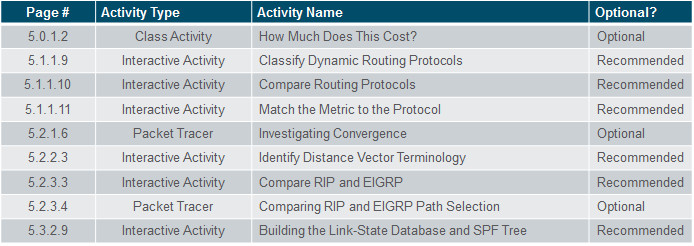
Assessment
Students should complete Chapter 5, “Assessment” after completing Chapter 5.
Quizzes, labs, Packet Tracers and other activities can be used to informally assess student progress.
Sections & Objectives
5.1 Dynamic Routing Protocols
Explain the features and characteristics of dynamic routing protocols.
Compare the different types of routing protocols.
5.2 Distance Vector Dynamic Routing
Explain how distance vector routing protocols operate.
Explain how dynamic routing protocols achieve convergence.
Describe the algorithm used by distance vector routing protocols to determine the best path.
Identify the types of distance-vector routing protocols.
5.3 Link-State Dynamic Routing
Explain how link-state protocols operate.
Describe the algorithm used by link-state routing protocols to determine the best path.
Explain how the link-state routing protocol uses information sent in a link-state update.
Explain the advantages and disadvantages of using link-state routing protocols.
Chapter 5: Dynamic Routing
5.1 – Dynamic Routing Protocols
5.1.1 – Types of Routing Protocols
5.1.1.1 – Classifying Routing Protocols
The purpose of dynamic routing protocols includes:
- Discovery of remote networks.
- Maintaining up-to-date routing information.
- Choosing the best path to destination networks.
- Ability to find a new best path if current path is no longer available.

5.1.1.2 – IGP and EGP Routing Protocols
Interior Gateway Protocols (IGP) – Used for routing within an Autonomous System (AS).
- RIP, EIGRP, OSPF, and IS-IS.
Exterior Gateway Protocols (EGP) – Used for routing between Autonomous Systems.
- BGP
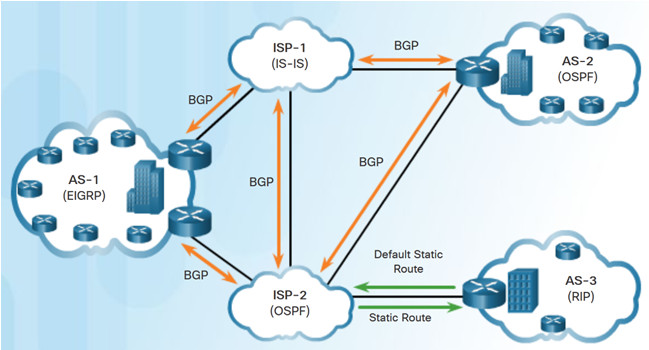
5.1.1.3 – Distance Vector Routing Protocols
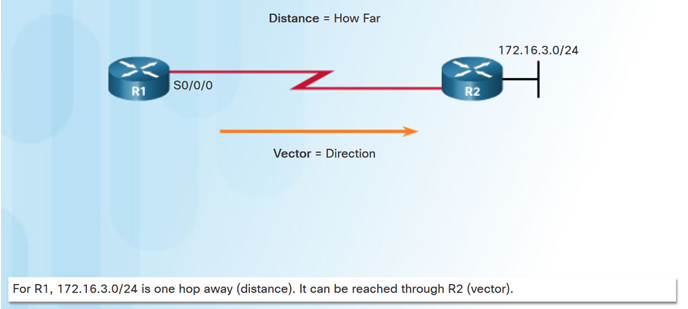
Distance vector means that routes are advertised by providing two characteristics:
- Distance – Identifies how far it is to the destination network based on a metric such as hop count, cost, bandwidth, delay.
- Vector – Specifies the direction of the next-hop router or exit interface to reach the destination.
RIPv1 (legacy), RIPv2, IGRP Cisco proprietary (obsolete), EIGRP.
5.1.1.4 – Link-State Routing Protocols
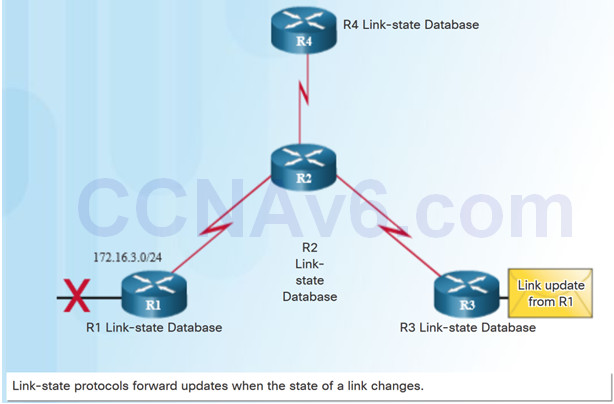
A link-State router uses the link-state information received from other routers:
- to create a topology map.
- to select the best path to all destination networks in the topology.
Link-state routing protocols do not use periodic updates.
- updates are only sent when there is a change in the topology
OSPF and IS-IS
5.1.1.5 – Classful Routing Protocols
Classless routing protocols include subnet mask information in the routing updates.
Classful routing protocols do not send subnet mask information in routing updates.
Classful routing protocols cannot support variable-length subnet masks (VLSMs) and classless interdomain routing (CIDR).
Classful routing protocols also create problems in discontiguous networks.
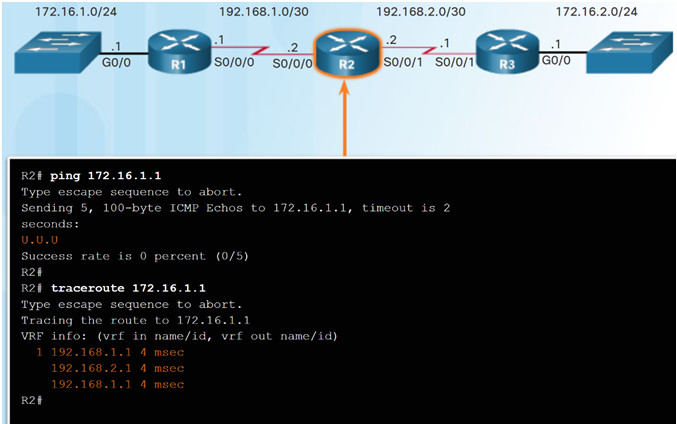
5.1.1.6 – Classless Routing Protocols
Classless IPv4 routing protocols (RIPv2, EIGRP, OSPF, and IS-IS) all include the subnet mask information in routing updates.
Classless routing protocols support VLSM and CIDR.
IPv6 routing protocols are classless.
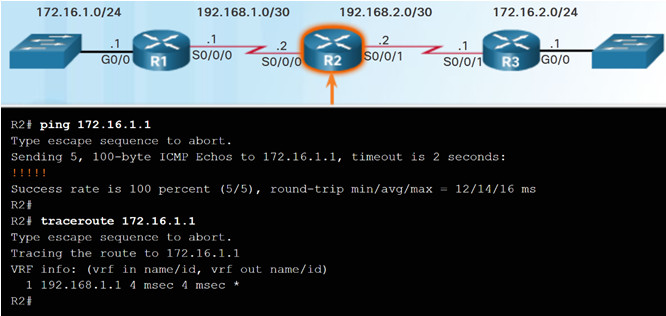
5.1.1.7 – Routing Protocol Characteristics
Routing protocols can be compared based on the characteristics in the chart.

5.1.1.8 – Routing Protocol Metrics
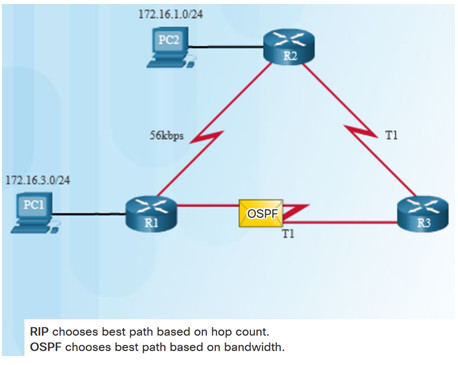
A metric is a measurable value that is assigned by the routing protocol to different routes based on the usefulness of that route.
Routing metrics are used to determine the overall “cost” of a path from source to destination.
Best path is route with the lowest cost.
Metrics used by various dynamic protocols:
- RIP – Hop count
- OSPF – Cost based on cumulative bandwidth
- EIGRP – Bandwidth, delay, load, and reliability.
5.2 – Distance Vector Dynamic Routing
5.2.1 – Distance Vector Fundamentals
5.2.1.1 – Dynamic Routing Protocol Operation
Operation of a dynamic routing protocol can be described as follows:
- The router sends and receives routing messages on its interfaces.
- The router shares routing messages and routing information with other routers using the same routing protocol.
- Routers exchange routing information to learn about remote networks.
- When a router detects a topology change, the routing protocol can advertise this change to other routers.
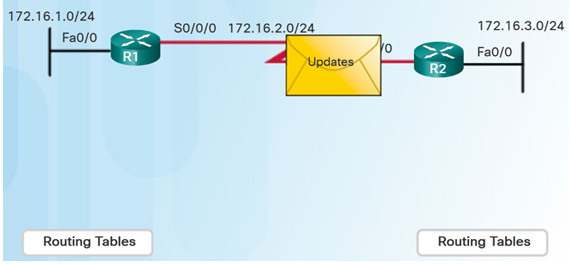
5.2.1.2 – Cold Start
After a router boots successfully it applies the saved configuration, then the router initially discovers its own directly connected networks.
- It adds those directly connected interface IP addresses to its routing table
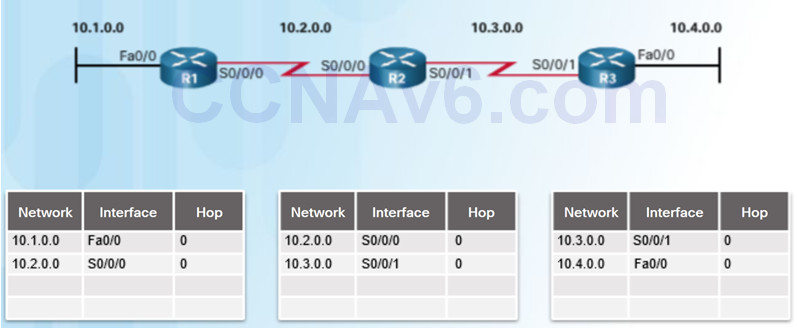
5.2.1.3 – Network Discovery
If a routing protocol is configured, the router exchanges routing updates to learn about any remote routes.
- The router sends an update packet with its routing table information out all interfaces.
- The router also receives updates from directly connected routers and adds new information to its routing table.
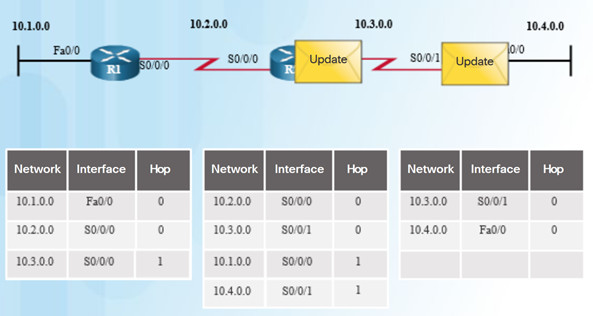
5.2.1.4 – Exchanging the Routing Information
Working toward convergence, the routers exchange the next round of periodic updates.
Distance vector routing protocols use split horizon to avoid loops.
Split horizon prevents information from being sent out the same interface from which it was received.
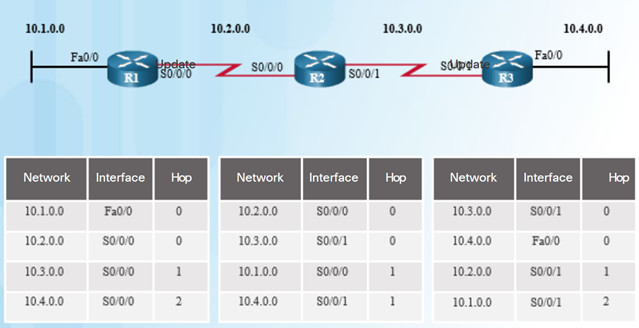
5.2.1.5 – Achieving Convergence
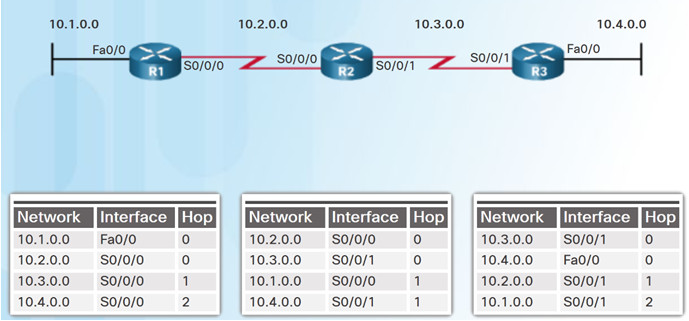
The network has converged when all routers have complete and accurate information about the entire network
Convergence time is the time it takes routers to share information, calculate best paths, and update routing tables.
Routing protocols can be rated based on the speed to convergence; the faster the convergence, the better the routing protocol.
5.2.1.6 – Packet Tracer – Investigating Convergence
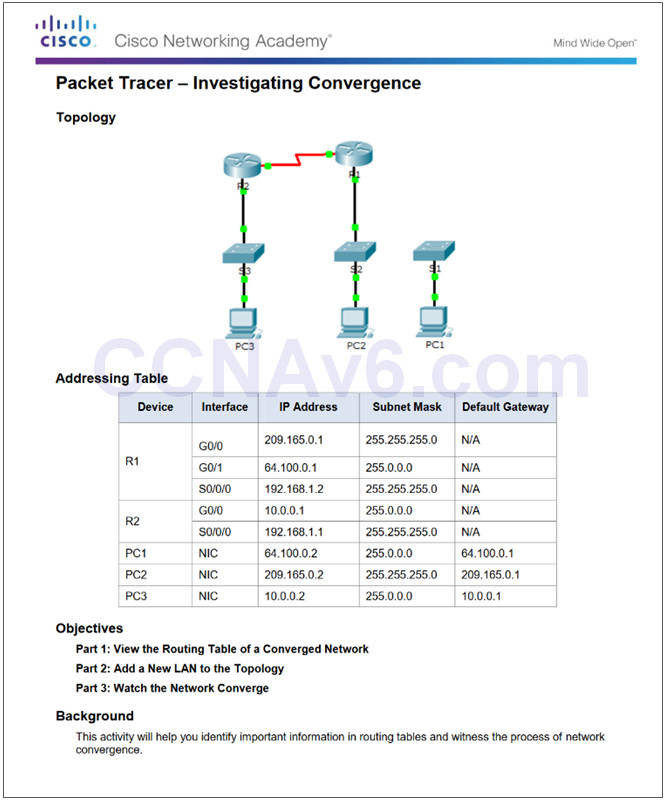
5.2.1.6 Packet Tracer – Investigating Convergence
5.2.2 – Distance Vector Routing Protocol Operation
5.2.2.1 – Distance Vector Technologies
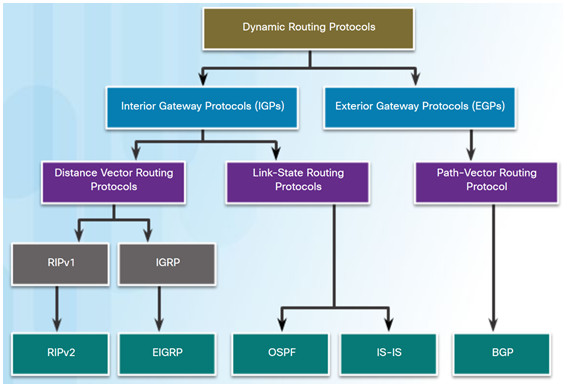
Distance vector routing protocols share updates between neighbors.
Routers using distance vector routing are not aware of the network topology.
Some distance vector routing protocols send periodic updates.
- RIPv1 sends updates as broadcasts 255.255.255.255.
- RIPv2 and EIGRP can use multicast addresses to reach only specific neighbor routers.
- EIGRP can use a unicast message to reach a specific neighbor router.
- EIGRP only sends updates when needed, not periodically.
5.2.2.2 – Distance Vector Algorithm

The distance vector algorithm defines the following processes:
- Mechanism for sending and receiving routing information
- Mechanism for calculating the best paths and installing routes in the routing table
- Mechanism for detecting and reacting to topology changes
RIP uses the Bellman-Ford algorithm as its routing algorithm.
IGRP and EIGRP use the Diffusing Update Algorithm (DUAL) routing algorithm.
5.2.3 – Types of Distance Vector Routing Protocols
5.2.3.1 – Routing Information Protocol
The Routing Information Protocol (RIP)
- Easy to confgure
- Routing updates broadcasted (255.255.255.255) every 30 seconds
- Metric is hop count
- 15 hop limit
RIPv2
- Classless routing protocol – supports VLSM and CIDR
- Increased efficiency – sends updates to multicast address 224.0.0.9
- Reduced routing entries – supports manual route summarization
- Secure – supports authentication
RIPng
- IPv6 enabled version of RIP
- 15 hop limit and administrative distance is 120

5.2.3.2 – Enhanced Interior-Gateway Routing Protocol
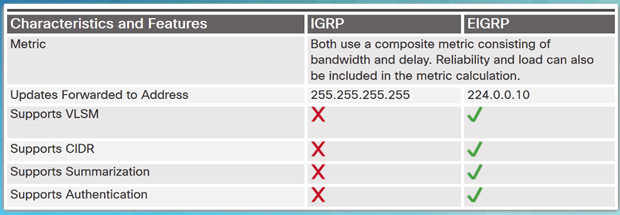
EIGRP replaced IGRP in 1992. It includes the following features:
- Bounded triggered updates – sends updates only to routers that need it.
- Hello keepalive mechanism – Hello messages are periodically exchanged to maintain adjacencies.
- Maintains a topology table – maintains all the routes received from neighbors (not only the best paths) in a topology table.
- Rapid convergence – because it maintains alternate routes.
- Multiple network layer protocol support – uses Protocol Dependent Modules (PDM) to support layer 3 protocols.
5.2.3.4 – Packet Tracer – Comparing RIP and EIGRP Path Selection
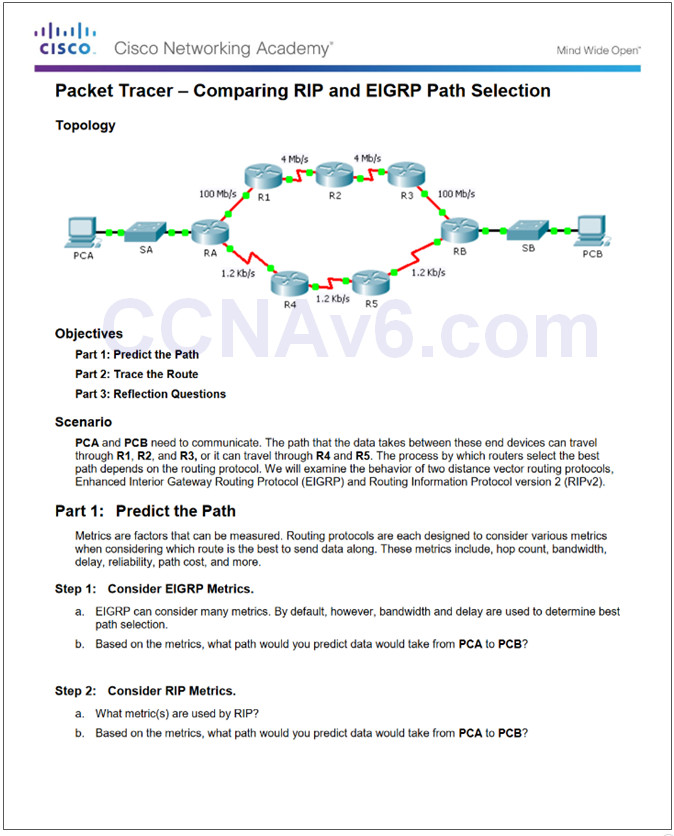
5.2.3.4 Packet Tracer – Comparing RIP and EIGRP Path Selection
5.3 – Link-State Routing Protocols
5.3.1 – Link-State Routing Protocol Operation
5.3.1.1 – Shortest Path First Protocols
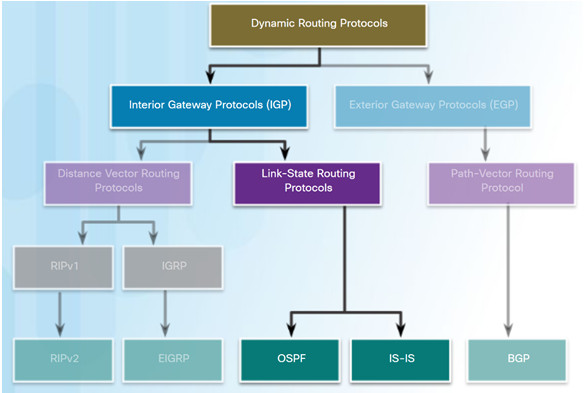
Link-state routing protocols, also known as shortest path first protocols, are built around Edsger Dijkstra’s shortest path first (SPF) algorithm.
IPv4 Link-State routing protocols:
- Open Shortest Path First (OSPF)
- Intermediate System-to-Intermediate System (IS-IS)
5.3.1.2 – Dijkstra’s Algorithm
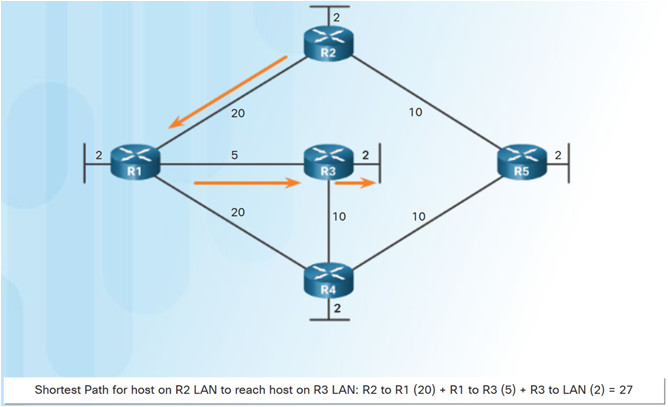
All link-state routing protocols apply Dijkstra’s algorithm (also known as shortest path first (SPF)) to calculate the best path route:
- Uses accumulated costs along each path, from source to destination.
- Each router determines its own cost to each destination in the topology.
5.3.1.3 – SPF Example
The table displays the shortest path and the accumulated cost to reach the identified destination networks from the perspective of R4.
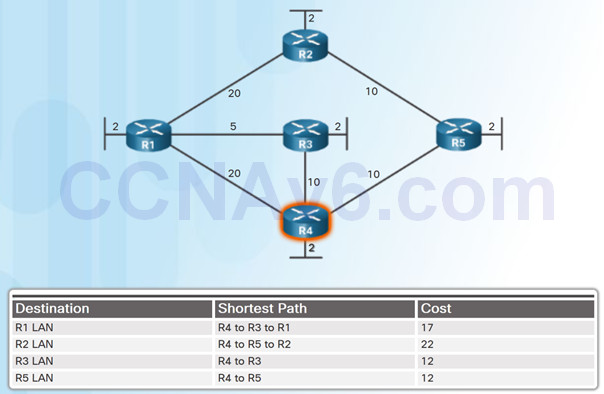
5.3.2 – Link-State Updates
5.3.2.1 – Link-State Routing Process

Note: This process is the same for both OSPF for IPv4 and OSPF for IPv6.
5.3.2.2 – Link and Link-State
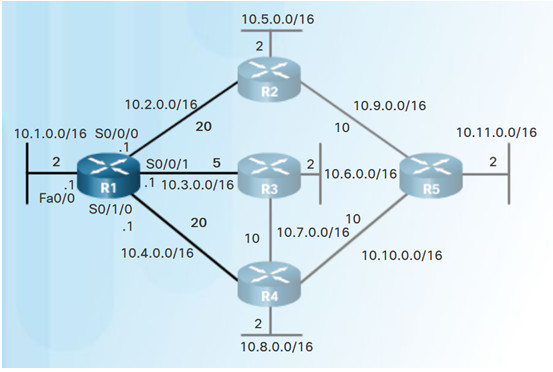
The first step in the link-state routing process is that each router learns its own directly connected networks.
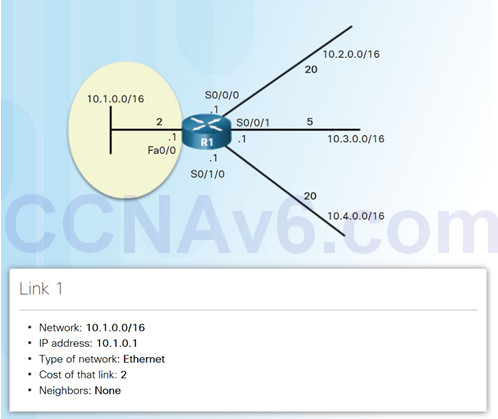
5.3.2.3 – Say Hello
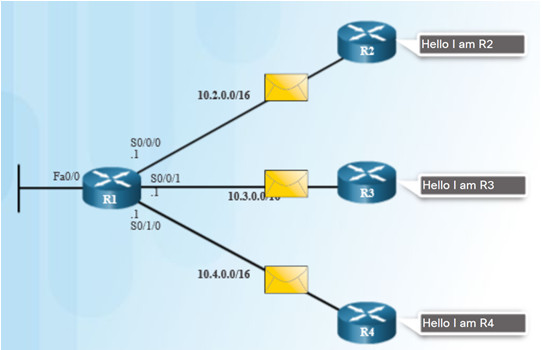
The second step in the link-state routing process is that each router uses a Hello protocol to discover any neighbors on its links.
When two link-state routers learn that they are neighbors, they form an adjacency.
If a router stops receiving Hello packets from a neighbor, that neighbor is considered unreachable.
5.3.2.4 – Building the Link-State Packet
The third step in the link-state routing process is that each router builds a link-state packet (LSP) that contains the link-state information about its links.
R1 LSP (in diagram) would contain:
- R1; Ethernet network 10.1.0.0/16; Cost 2
- R1 -> R2; Serial point-to-point network; 10.2.0.0/16; Cost 20
- R1 -> R3; Serial point-to-point network; 10.3.0.0/16; Cost 5
- R1 -> R4; Serial point-to-point network; 10.4.0.0/16; Cost 20
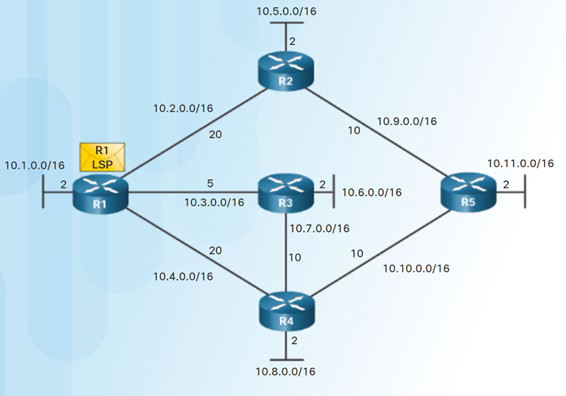
5.3.2.5 – Flooding the LSP
The fourth step in the link-state routing process is that each router floods the LSP to all neighbors.
An LSP only needs to be sent:
- During initial startup of the routing protocol process on that router (e.g., router restart)
- Whenever there is a change in the topology (e.g., a link going down)
An LSP also includes sequence numbers and aging information:
- used by each router to determine if it has already received the LSP.
- used to determine if the LSP has newer information.

5.3.2.6 – Building the Link-State Database
The final step in the link-state routing process is that each router uses the database to construct a complete map of the topology and computes the best path to each destination network.
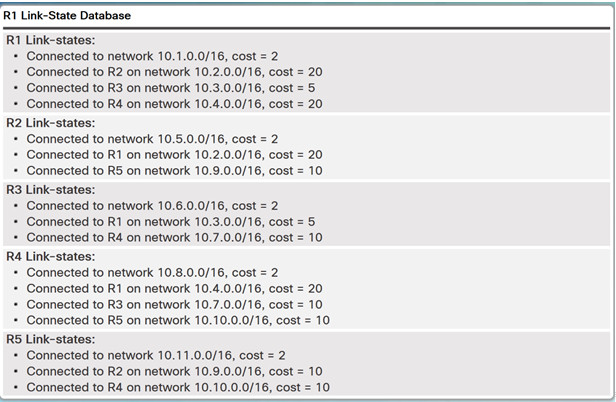
5.3.2.7 – Building the SPF Tree
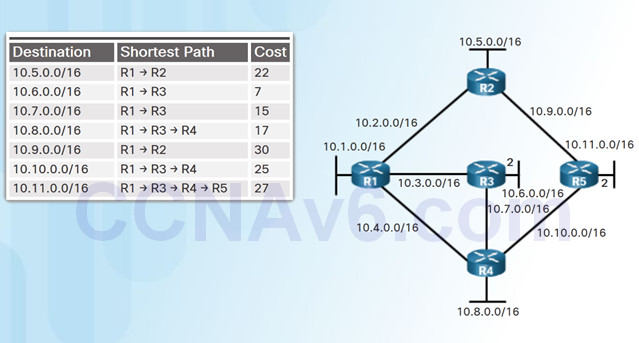
Each router uses the link-state database and SPF algorithm to construct the SPF tree.
- R1 identifies its directly connected networks and costs.
- R1 adds any unknown networks and associated costs.
- The SPF algorithm then calculates the shortest paths to reach each individual network resulting in the SPF tree shown in the diagram.
Each router constructs its own SPF tree independently from all other routers.
5.3.2.8 – Adding OSPF Routes to the Routing Table
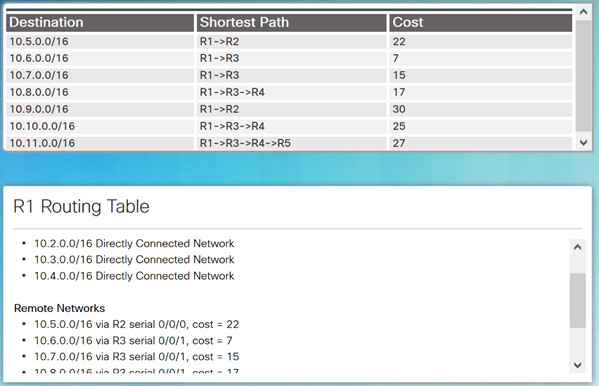
Using the shortest path information determined by the SPF algorithm, these best paths are then added to the routing table.
Directly connected routes and static routes are also included in the routing table.
5.3.3 – Link-State Routing Protocol Benefits
5.3.3.1 – Why Use Link-State Protocols?

5.3.3.2 – Disadvantages of Link-State Protocols
Disadvantages of Link-State protocols:
- Memory Requirements – Link-state protocols require additional memory.
- Processing Requirements – Link-state protocols can require more CPU processing.
- Bandwidth Requirements – The flooding of link-state packets can adversely affect bandwidth.
Using multiple areas can reduce the size of the link-state databases.
Multiple areas can limit the amount of link-state information flooding and send LSPs only to those routers that need them.
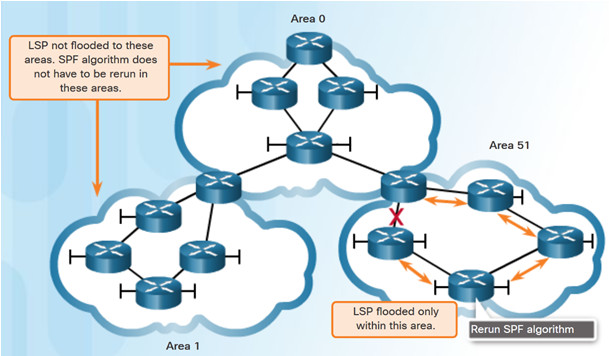
5.3.3.3 – Protocols that Use Link-State
Two link-state routing protocols, OSPF and IS-IS.Open Shortest Path First (OSPF) – most popular implementation with two versions in use:
- OSPFv2- OSPF for IPv4 networks (RFC 1247 and RFC 2328)
- OSPFv3- OSPF for IPv6 networks (RFC 2740)
- Integrated IS-IS, or Dual IS-IS, includes support for IP networks.
- used mainly by ISPs and carriers.

5.4 – Summary
5.4.1 – Conclusion
5.4.1.1 – Chapter 5: Dynamic Routing
Explain the features and characteristics of dynamic routing protocols.
Explain how distance vector routing protocols operate.
Explain how link-state protocols operate.
New Terms and Commands
| •best path
•Interior Gateway Protocol (IGP) •Exterior Gateway Protocol (EGP) •path-vector •classless •Routing Information Protocol version 1 (RIPv1) •Interior Gateway Routing Protocol (IGRP •Routing Information Protocol version 2 (RIPv2 •Enhanced Interior Gateway Routing Protocol (EIGRP) •Open Shortest Path First (OSPF) •Intermediate System to Intermediate System (IS-I •Border Gateway Protocol (BGP) •classless routing protocols •autonomous system (AS) •Distance |
•metric
•cost •periodic updates •neighbors •Variable-Length Subnet Mask (VLSM) •Classless Inter-Domain Routing (CIDR) •convergence •route summarization •Bellman-Ford algorithm •Dijkstra’s algorithm •Shortest Path First (SPF) algorithm •Diffusing Update Algorithm (DUAL) •directly connected networks •split horizon •converge •Convergence time |
| •multicast addresses
•RIPng •administrative distance •SPF tree •link state information •OSPF area •link-state routers •Hello packets •Link-State Packets (LSP) •router ID •All OSPF routers •link-state database (LSDB) •adjacency •OSPFv2 •OSPFv3
|

GOOD